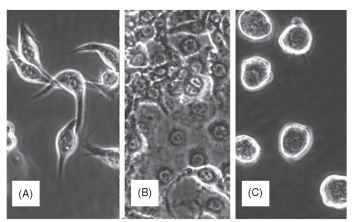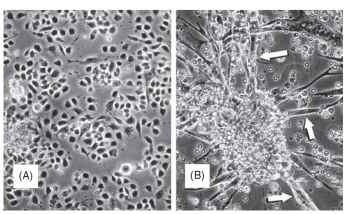Cell culture is the technique in which cells are removed from ■ an organism and placed in a fluid medium. Under proper conditions, the cells can live and even grow. The growth can be characterized by cell division (mitosis) or by other processes, such as differentiation, during which the cells can change into specific types that are capable of functions analogous to tissues or organs in the whole organism. The practice of cell culture (and its close cousins, tissue culture and organ culture) originated in a Yale University laboratory in 1907, when Ross Harrison removed nerves of a frog and maintained them in a simple salt solution for several days. Within a very few years a visiting scientist in Harrison’s laboratory, Richard Goldschmidt, reported on the first cell cultures from an insect. For the next half-century, insect cell culture was used periodically in a variety of experiments, such as studying the pathogenesis of viruses, but the field received a great boost when the Australian Thomas D. C. Grace succeeded in obtaining four cell lines from the emperor gum moth, Antheraea eucalypti. These lines were capable of continuous growth, requiring periodic subculturing.
In the years since Grace’s report, numerous other continuous insect cell lines have been developed—over 500 lines from more than 100 different insect species. Under microscopic examination, cells take on one of several distinct morphologies, including spindle shaped, epithelial, and round to oval (Fig. 1). Cell cultures are frequently used in research and biotechnology.

FIGURE 1 Typical appearances of insect cells in culture by phase contrast microscopy: (A) spindle shaped (fibroblast-like), (B) epithelial shaped, and (C) round.
USES IN PHYSIOLOGY AND DEVELOPMENTAL BIOLOGY
Harrison’s earliest work was designed to examine the physiology of a nerve outside the living organism, and similar uses have been made of insect cells and tissue. By removing the tissue or cells from the insect, it is possible to delineate how individual compounds affect them. Some of the most useful work has been with ecdysone,the insect molting hormone. In 1972 Anne-Marie Courgeon showed that exposing a cell line from Drosophila melanogaster to (3-ecdysone (a particular form of ecdysone now known as 20-hydroxyecdysone) caused rounded cells to change to aggregates of highly elongated cells. Lynn and Hung found that a cell line from a small wasp can undergo a similar morphogenesis with the added feature that the elongated cells are highly contractile, like muscle cells (Fig. 2 ).

FIGURE 2 Cell shape change in response to treatment with the insect-molting hormone: (A) untreated cells and (B) cells treated for 2 weeks with 20-hydroxyecdysone. Arrows point to cells that were contracting in the culture.
USES IN PATHOLOGY
Certain disease-causing organisms, such as viruses, rickettsia, and certain protozoans are obligate pathogens. Cell cultures can be extremely useful with such pathogens because this is often the only way to grow them outside a whole animal or plant and make them much easier to study. Some of the early work with insect cell culture was initiated with a group of viruses known as nucleopolyhedrovirus. These viruses cause diseases in a large number of pest insects and thus are potential biological control agents. Cell cultures grown in large volumes can be used to produce these viruses for biologically based pesticides.
Some insects are also notorious for their ability to transmit diseases (such as malaria and yellow fever) to higher animals and plants. Cell cultures from mosquitoes and other insects can also be used to study these pathogens.
USES IN MEDICINE AND PHARMACOLOGY
Decades ago, researchers showed that a gene in baculoviruses could be replaced through genetic engineering with genes for other proteins. When insect cells are infected with these modified viruses, the cultures can produce a large quantity of the protein. This tech-nique—the baculovirus expression vector system—has facilitated a new use for insect cell cultures for the production of vaccines, growth factors, and other materials useful in medicine. Over 1800 articles have been published on the use of insect cells to produce various recombinant proteins.
